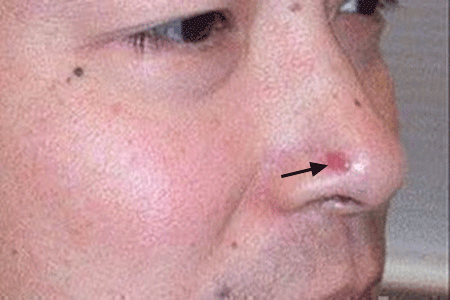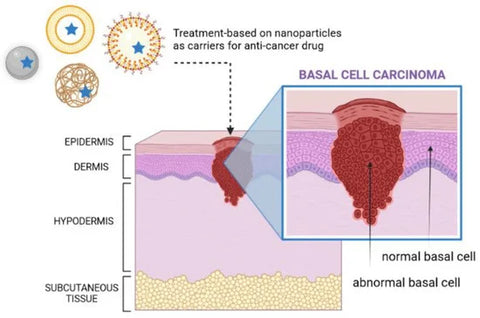2023年5月8日
David Kelly's Experience with Basal Cell Carcinoma
What is Basal Cell Carcinoma and How to treat it?
I've always been careful about sun protection. I use sunscreen and wear a long-sleeved Rash Guard when surf. I'm also more susceptible to skin cancer because of the meds that I'm on to suppresses my immune system. I had a kidney transplant about 24 years ago so I get yearly dermatology appointments.
One day, I noticed a small black dot on my right nostril. It looked like a tiny mole , but it didn't bother me much. Until it started to hurt.

Photo from: www.advancedskinmd.com
It felt like a pimple that was about to pop, so I decided to see a dermatologist. She took one look at it and said it was basal cell carcinoma. She explained that it was a type of skin cancer that was caused by sun damage, but it was very common and treatable.
I was nervous about having surgery on my face, but I knew it was necessary. I had Mohs surgery, which is a specialized procedure that is very effective at removing basal cell carcinoma.
During Mohs surgery, the surgeon removes thin layers of tissue one at a time and examines them under a microscope until all of the cancer cells are gone. My actual procedure only took 10 mins, but waiting for it to be examined took about an hour or so.
My surgery went well, and I had a small scar on my nostril. But the scar was barely noticeable, and I was so relieved to have the cancer gone.
What is basal cell carcinoma?
Basal cell carcinoma (BCC) is the most common type of skin cancer. It is caused by the uncontrolled growth of basal cells, which are the cells that make up the bottom layer of the epidermis, the outermost layer of skin.
BCC is typically slow-growing and does not metastasize, meaning it does not spread to other parts of the body. However, if left untreated, it can grow large and destroy surrounding tissue.

Photo from: www.mdpi.com
What does basal cell carcinoma look like?
BCC can take many different forms. It can appear as a:
- Pearly or waxy bump
- Open sore or ulcer
- Red patch or growth
- Pink or brown growth with a scaly surface
- Scar-like growth
BCC can often be diagnosed by its appearance alone, but a dermatologist may also perform a biopsy to confirm the diagnosis.
What to look for:
If you notice any changes in your skin, such as a new mole, a sore that won't heal, or a change in the size or shape of an existing mole, see a dermatologist right away.
BCC is most common on sun-exposed areas of the body, such as the face, ears, neck, and hands. However, it can occur anywhere on the body.
What happens if you don't take care of basal cell carcinoma?
If left untreated, BCC can grow large and destroy surrounding tissue. This can lead to disfigurement, and in some cases, the cancer can invade deeper tissues and organs.
BCC is very rarely life-threatening, but it is important to treat it early to prevent complications.
Surgery for basal cell carcinoma
The most common treatment for BCC is surgery. Surgery involves removing the cancer and a small margin of surrounding healthy tissue.
There are several different types of surgery that can be used to treat BCC, depending on the size and location of the tumor. The most common type of surgery is Mohs surgery.
Mohs surgery
Mohs surgery is a specialized procedure that is very effective at removing BCC. During Mohs surgery, the surgeon removes thin layers of tissue one at a time and examines them under a microscope until all of the cancer cells are gone.
Mohs surgery is a very precise procedure, and it helps to ensure that all of the cancer cells are removed while minimizing damage to healthy tissue.
How was Mohs surgery developed?
Mohs surgery was developed by Dr. Frederic Mohs in the 1930s. Dr. Mohs was a dermatologist who was frustrated by the high recurrence rate of BCC after traditional surgery.
Dr. Mohs developed a new technique that involved removing thin layers of tissue one at a time and examining them under a microscope until all of the cancer cells were gone. This new technique was very effective, and it is now the most common treatment for BCC.
Basal cell carcinoma is the most common type of skin cancer, but it is also very treatable if caught early. If you notice any changes in your skin, see a dermatologist right away.
Read More 👈
